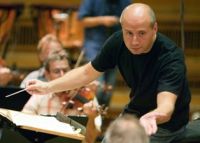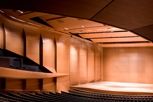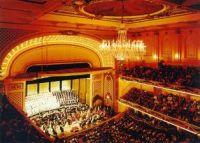Järvi, Deutsche Kammerphilmonie Bremen Exciting, Arresting in Reopened Alice Tully Hall
Mary Ellyn Hutton
Posted: Mar 4, 2009 - 8:04:45 PM in
reviews_2009

Paavo Järvi conducting the Deutsche Kammerphilharmonie Bremen (photo by Julia Baier)
|

Interior of renovated Alice Tully Hall
|
MusicinCincinnati.com has never been so grateful for Cincinnati’s Music Hall as on Monday evening (March 2) in newly re-opened Alice Tully Hall in New York.

Interior of Music Hall in Cincinnati
|
Music Hall, with its 3,516 seats, is too big to afford an intimate experience between performers and listeners. It delivers handsomely, however, for the music. Acoustics are not the problem. Engaging the audience, player/conductor morale and selling tickets when good seats are known to be easily available, are.
What a shame it is then that the touring Deutsche Kammerphilharmonie Bremen, which performed four Beethoven symphonies in a double whammy evening March 2 in Alice Tully Hall, did not perform in Cincinnati as well.
A tour stop initially planned for Cincinnati failed for lack of a sponsor, though the city’s reluctance to host visiting ensembles is notorious, no doubt exacerbated in this case by the fact that DK artistic director Paavo Järvi is also music director of the Cincinnati Symphony Orchestra.
There is no lack of intimacy in the new Alice Tully Hall, which seats between 923 and 1,087, depending on which stage extension is used. There are three, which bring the stage successively further out into the hall. The second was used for the DK concert, so you can estimate about 1,000 seats, most of which were filled. (The 7:30 p.m. performance was officially sold out, though there were empty seats both for it and the 10:30 p.m. concert, perhaps due to the messy, frigid weather.)
You could see the rosin on the string players’ fingerboards, watch their vigorous bowing, see them snap off broken bow hairs and generally enjoy the bonhomie between Järvi and his visibly energized musicians. There was plenty of audience enthusiasm, too, especially at the 10:30 p.m. concert, which drew a younger, hipper crowd.
Admittedly, the Järvi/DK Beethoven symphonies, recorded on a five-CD set, with three released in the U.S. so far (RCA Red Seal), make for a new kind of Beethoven experience. While being textually faithful to the Bonn master and adopting some authentic performance practices – small orchestra (41 players), mixed string vibrato, hard sticks on the timpani -- it’s as close to rock and roll as Beethoven has come so far, at least in the concert hall.
Re-interpreting Beethoven as Järvi and his dedicated players have done is laudable in every respect, and one wishes more power to them and to others who may feel called upon to do so.
Still, for this listener (and others, at both concerts), beauty of sound was lacking in Alice Tully Hall. The new wood veneers were oddly ineffective in making it bloom. Music Hall, with its warm, player-friendly acoustics would have been ideal for the DK’s visceral approach.
That said, it was an exciting, arresting event -- a trailblazer, one might venture -- in the quest for new audiences for classical music. Symphonies No. 8 and 3 ("Eroica") were performed on the first concert (7:30 p.m.), No. 1 and No. 7 on the second (10:30 p.m.).
Because of the heavy snowfall and canceled flights into New York, this listener was unable to get to the hall until well after 8 p.m., just as the second half of the earlier concert was beginning. Lincoln Center’s strict no-late-seating policy forbade entrance to the auditorium (now re-named Starr Theater). Apparently, even viewing the TV monitor in the lobby is a no-no. Fortunately, the Tully Hall staff did permit me to sit in the photo booth at the rear of the auditorium for most of the “Eroica," which made up the second half of the concert.
The sound within the photo booth was, of course, not representative of the hall, but the accuracy, vigor and visual aspect of the performance could be observed. I had heard Järvi and the DK perform the “Eroica” in the old Alice Tully Hall in 2004, so I had a memory of that to go on, plus familiarity with their Beethoven recordings. Perhaps I am more accustomed to their Beethoven style now than I was in 2004, but I found Monday’s “Eroica” more genuinely emotional and well defined than I did then.
In the Marcia funebre, for instance, the woodwind soloists sometimes “bent” their lines,somewhat like stifling a sob, and timpanist Stefan Rapp punched out his lines as if in anguish.
Järvi positively relished the rhythms of the Scherzo and the finale brimmed with character, from the introduction, where he held the first note briefly before plunging into the sixteenth-notes which spill from it, through each succeeding variation. There were swaying, waltz-like moments, chirpy ones (flute), rustic dotted rhythms heavily applied and thrilling swells in the horns. The oboe variation took its time for a sigh or two, and the cellos prepared the concluding presto dash for the finish line with some fun-to-watch bowing where they hammered exuberantly at the strings. Audience response was warm (but not wild), with a few listeners standing and applauding enthusiastically.
Järvi rewarded them with one of his trademark encores, Sibelius’ “Valse Triste,” where he took the orchestra from super-soft pianissimos to wild fury, ending in an almost ghastly whimper (“Valse Triste” is a ghost story after all).
The late evening concert opened with the Symphony No. 1, where Järvi asked the violins to arpeggiate their opening pizzicato chords to give them a strummed effect (not entirely convincing). Again, there was some very picturesque bowing, with the string players raising their bows high off the string between strokes. The Andante Cantabile, taken at a rapid pace, was dance-like in the extreme, with exaggerated effects, including an elegant loud to soft final bar.
Timpanist Raff ended the first phrase of the Menuetto with an unrestrained blow, while the violins bubbled merrily in the contrasting Trio. There was an audible, cleansing breath by the entire orchestra before the final movement, where the first violins tip-toed charmingly (and carefully) into the challenging sixteenth-note sprint with which the movement proper begins. Ensemble was admirable here, indicating that everyone in the DK practices their scales diligently. At times, however, it had a nervous edge, perhaps attributable to the unforgiving acoustics.
The Symphony No. 7 opened with a bang and here, again, everything was shaped in astonishing, painstaking detail. Järvi dwelt on harmonic suspensions, letting dissonances cut sharply through the texture. Bowing by the string players was so lusty as to become tantamount to sawing now and then, perhaps frustrating the hoped-for acoustic effect, but the spirit was always crystal clear.
Järvi plunged immediately into the Allegretto, giving it a dark, intensely emotive color, before breaking the spell in the scherzo. Here he asked for and got some of the evening’s hardest work from the orchestra. The wood of the bass bows could sometimes be heard slapping against their instruments and there was a glaring wrong note (?) in the woodwinds on a melodic line in the Trio.
The finale was high octane all the way, as the players ground out its incessant rhythms. The horns soared over the winds early on and at the end, and everywhere brass comments were stinging. Järvi’s conspicuous ally in creating the excitement was concertmaster Florian Donderer, whose body language ratified Järvi's and helped unite the ensemble in the tricky rhythmic and dynamic shaping throughout.
Järvi whipped them into a fury in the blazing Coda, bringing the helpless audience to their feet en masse as he spun around to face them at the end. The ovation was sustained and the orchestra awarded a foot-stomping solo bow to their conductor.
Encore was the second movement (Allegretto scherzando) of the Symphony No. 8, giving this listener a chance to hear at least that much of the symphony, which was performed on the missed first half of the 7:30 p.m. concert. All was exactitude here, with perky woodwinds, charmingly metronomic "ticking" and prim viola/second violin pizzicato underlining the violin melody. It made a great chaser for the concert, which ended just after midnight.



